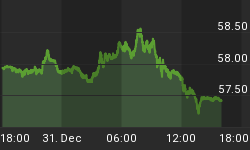There is an exquisite setup building once again. Tight fundamentals in the gold market apply upwards pressure on the price. For quite a while, we have been saying gold's fundamental price was around a hundred bucks above the market price. Well, the market price moved up $46 this week. What happened to the fundamental price? You'll have to read on to see (no cheating and reading ahead!) but suffice to say it's quite a bit higher than the market.
At the same time, the fundamental price of silver is below the market price. We included a graph last week, showing that gold is being sold at a discount and silver at a premium to their fundamental prices. The price of silver moved up this week, though it didn't move like gold. It was up, then down, then up, then back down, ending a mere nine cents higher than last week. In fact, on Friday, the price of gold went up about 0.8% but the price of silver dropped 1.7%.
And this is the crux. According to popular belief, the prices of the metals are supposed to move together. Silver is supposed to go up when gold goes up, only more. This is due to money printing, inflation, economic fear, anticipation of further policy madness from the Fed, or whatever. It's much clearer when you price everything in gold.
The fundamentals for silver just aren't there right now. What happens when a trading thesis is believed by just about everyone?
These are the market upsets about which stories are told years later.
Could we see gold with a 13 handle and silver with a 14 handle? Read on...
First, here is the graph of the metals' prices.
The Prices of Gold and Silver

We are interested in the changing equilibrium created when some market participants are accumulating hoards and others are dishoarding. Of course, what makes it exciting is that speculators can (temporarily) exaggerate or fight against the trend. The speculators are often acting on rumors, technical analysis, or partial data about flows into or out of one corner of the market. That kind of information can't tell them whether the globe, on net, is hoarding or dishoarding.
One could point out that gold does not, on net, go into or out of anything. Yes, that is true. But it can come out of hoards and into carry trades. That is what we study. The gold basis tells us about this dynamic.
Conventional techniques for analyzing supply and demand are inapplicable to gold and silver, because the monetary metals have such high inventories. In normal commodities, inventories divided by annual production (stocks to flows) can be measured in months. The world just does not keep much inventory in wheat or oil.
With gold and silver, stocks to flows is measured in decades. Every ounce of those massive stockpiles is potential supply. Everyone on the planet is potential demand. At the right price, and under the right conditions. Looking at incremental changes in mine output or electronic manufacturing is not helpful to predict the future prices of the metals. For an introduction and guide to our concepts and theory, click here.
Next, this is a graph of the gold price measured in silver, otherwise known as the gold to silver ratio. The ratio moved up sharply this week.
The Ratio of the Gold Price to the Silver Price

For each metal, we will look at a graph of the basis and cobasis overlaid with the price of the dollar in terms of the respective metal. It will make it easier to provide brief commentary. The dollar will be represented in green, the basis in blue and cobasis in red.
Here is the gold graph.
The Gold Basis and Cobasis and the Dollar Price

The price of the dollar dropped considerably, from 27.9mg to 26.8mg gold (i.e. the price of gold rose). However, the cobasis didn't drop much and the basis (i.e. abundance) actually fell a bit.
The fundamental price moved up almost as much as the market price, and it's still about a hundred bucks above the market.
There are two interesting points worth noting here. One, if this rising price of gold gets traders excited, there's no reason why the market price couldn't overshoot. Second, the rising price could motivate stackers to go out and buy before the price goes even higher. In other words, the fundamental could rise as well, in a positive feedback loops.
We make no prediction of $1,300+ gold. We are interested in valuing the metal, not timing the market. However, as market observers we see $1,300 as quite possible without much of a stretch.
Now let's look at silver.
The Silver Basis and Cobasis and the Dollar Price

The price of silver went up. However, the cobasis (i.e. scarcity) is much lower than in gold -- negative -- and it fell.
We calculate a fundamental price of silver more than 50 cents below the market price.
Next week, we will talk about how we calculate fundamental prices and how they differ from the market price.
Monetary Metals will be in New York City on Friday afternoon, September 11. You are cordially invited to join us for a discussion of economics and markets, with a focus on how to approach saving, investing, and speculating. Midtown. RSVP here.
















